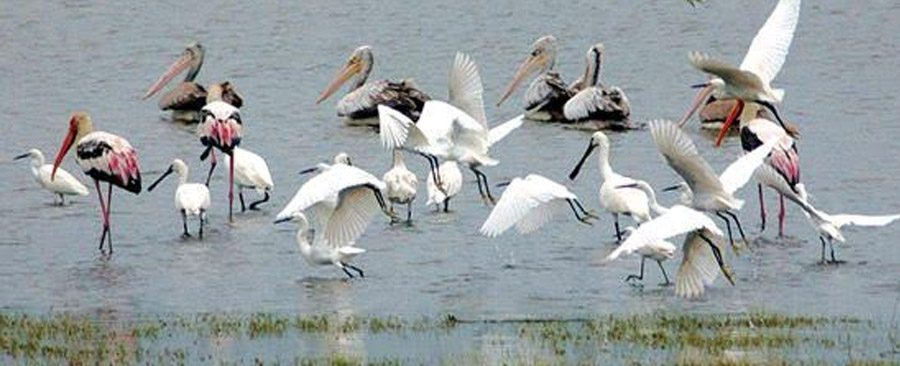
Bundala National Park is an internationally important wintering ground in Sri Lanka for migratory water birds. Bundala harbors 197 species, the highlight being the Greater Flamingo, which migrate in large flocks. Bundala was designated a wildlife sanctuary in 1969 and redesignated to a national park on 4 January 1993. In 1991 Bundala became the first wetland to be declared as a Ramsar site in Sri Lanka. In 2005 the national park was designated as abiosphere reserve by UNESCO, the fourth biosphere reserve in Sri Lanka. The national park is situated 245 km southeast of Colombo.
The area mainly underlain with hornblende biotite gneiss of the eastern Vijayan series. The low country dry zone climate prevails in the area. Bundala area receives 1,074 mm of annual rainfall. Although the area receives substantial rainfall during the North-eastern monsoon season, dry climate persists rest of the year. The proximity to the Indian Ocean helps to ameliorate the temperatures. The mean annual temperature is around 28.0°C. But temperature rise in the months of April, May and June. The national park have a high relative humidity ratio of 80%. The national park consists four lagoons, Bundala lagoon of 520 ha, Embilikala lagoon of 430 ha, Malala lagoon 650 ha and Koholankala lagoon of 390 ha.
The Phytoplankton in all the lagoons is dominated by blue-green algae including species such as Macrocystis Nostoc, Oscillatoria. Hydrilla is in abundance in lagoons such as Embilikala and Malala. Water hyacinth, water lilies, and Typha angustifolia reed beds are found in the marshes and streams. The vegetation mainly consists of Acacia scrubs including Dichrostachys cinerea, Randia dumetorum, Ziziphus sp., Gymnosporia emarginata, Carissa spinarum Capparis zeylanica and Cassia spp.. The trees of the forest are Bauhinia racemosa Salvadora persica Drypetes sepiaria, and less common Chloroxylon swietenia Azadirachta indica, and Feronia limonia. plants thrive in the national park's environmental conditions. Salicornia brachiata and Halosarcia indica are examples of salt-tolerant plants. Lumnitzera racemosa trees found the small mangrove area.
Bundala is an important bird sanctuary. About 100 species of water birds inhabit the wetland habitats in Bundala, half of them being migrant birds. Greater Flamingo which visits in large flocks of over 1,000 individuals, from Rann of Kutch of India is being the highlight in the past. Other water birds which are present in large numbers include Lesser Whistling Duck, Garganey, Little Cormorant, Indian Cormorant, Grey Heron, Black-headed Ibis, Eurasian Spoonbill Asian Openbill, Painted Stork, medium sized waders, Tringa subspecies, and small waders, Charadrius subspecies. Black-necked Stork, Lesser Adjutant and Eurasian Coot are rare birds inhabit in the national park.
The forest is an important habitat for the endangered Sri Lankan Elephant, the largest subspecies of Asian Elephant. Sri Lankan Sambar Deer, Sri Lankan Leopard, Wild boar, Indian Gray Mongoose, Sri Lankan Sloth Bear, Sri Lankan Axis Deer, Small Indian Civet, Golden Jackal, and Indian Crested Porcupine are the other mammals found in the park.